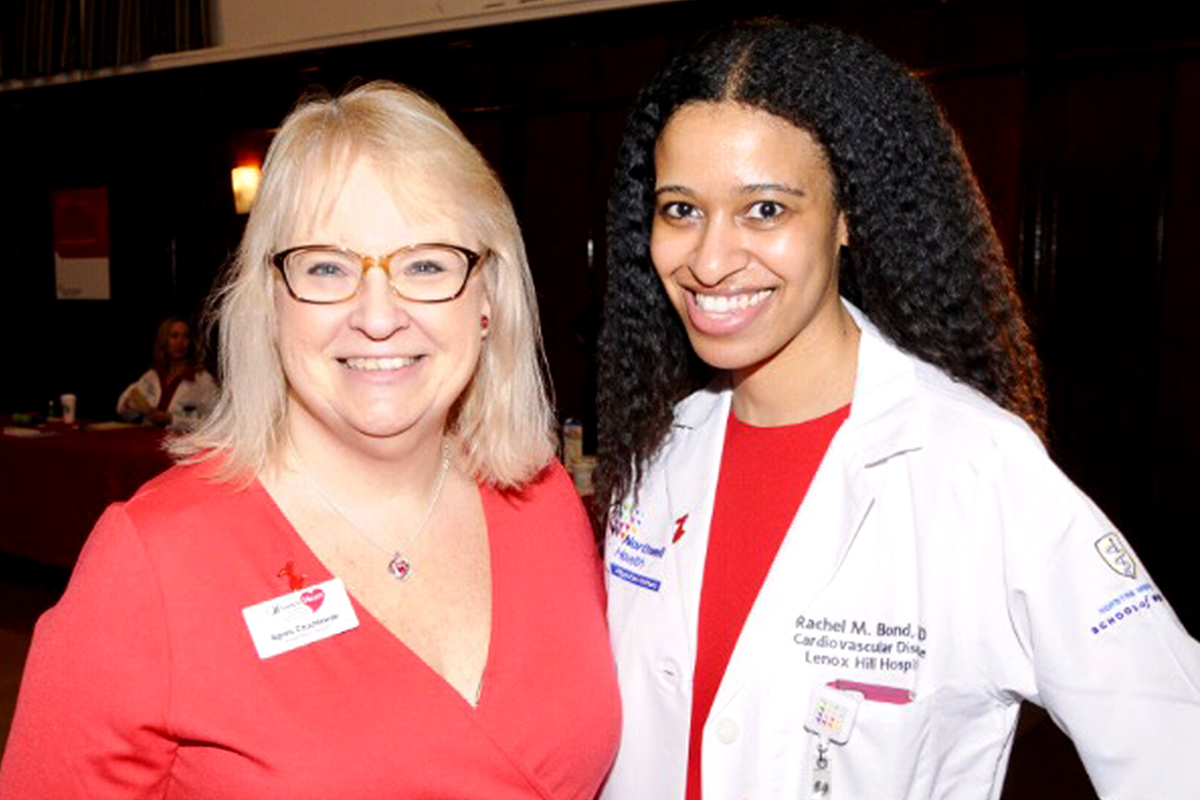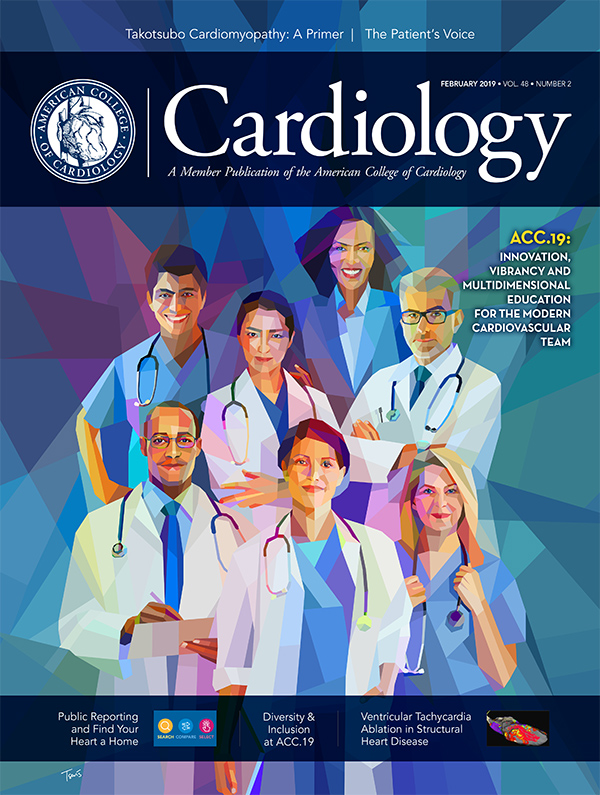The Patient’s Voice | Patient Empowerment: Through the Eyes of Doctor and Patient

"December 2015 was shaping up to be an intense holiday season. With 13 people coming for Christmas dinner and some staying for more than a week, there was a lot of cooking, cleaning and family. Although the preparations were moving along well, something was not right ..."
And so begins the story of Agnes Czuchlewski, heart attack patient turned WomenHeart Champion, support network coordinator and community educator. Czuchlewski recently joined her cardiologist Rachel Bond, MD, FACC, at ACC's Industry Advisory Forum held in New York City to not only provide a first-hand look at what a successful physician-patient can look like, but also participate in a panel focused on opportunities to incorporate the patient voice into cardiovascular care.
Bond and Czuchlewski spoke with Cardiology about their experiences and offer their insights for clinicians and patients on the meaning of patient empowerment, biggest challenges and strategies that really work.
Dr. Bond, describe the meaning and importance of patient empowerment.
Patient empowerment has emerged as a new paradigm. It is a process through which people gain greater control over decisions and actions affecting their own health.
Patient empowerment is also twofold. By empowering patients to take co-responsibility for the management of their condition, it may not only enhance medical outcomes but also lower costs. It is important to remember that empowering patients does not mean disempowering health care professionals. Patients can only be empowered by their health care provider through constant medical feedback, which allows for a smooth path towards self-responsibility.
Dr. Bond's Four Core Strategies to Empower, Engage Patients
- Health 5.0. The health system has made a natural shift from a more patient-centric health care system to a customer-centric well-being system. This change means our focus is no longer just on disease and treatment, but mostly on prevention and wellness. We have the ability to address the needs of patients even before they become sick. This process helps with forming a lifelong partnership between the patient and their health care provider.
- Patient expectations. In 2019, it should come as no surprise that a vast majority of consumers use technology as an important tool for the management of their health. Many surveys have shown that consumers are more likely to select a provider who allows them to conduct health care interactions online through patient engagement technology. I encourage my patients to use this technology to have direct access to test results, information on health conditions and timely communication with my staff or me.
- Patient engagement technology. Specific forms of patient engagement technology include mobile health applications such as ACC's CardioSmart Heart Explorer App. This app reviews common cardiac problems and treatment options, as well as provides patients with several decision aids for specific conditions. Other possible engagement technology tools include the use of personalized patient portals through the electronic health records, which enable direct and timely communication with providers, display test results and health summaries, list medications, facilitate prescription refills, schedule appointments, and record patient-generated health data such as in-home medical devices or wearable devices. These patient-generated health data devices help our patients to take control of certain health conditions and even find them before symptoms may arise.
- Health education. Health education is likely the most valuable in allowing full patient engagement. It helps bridge any potential communication gaps, activates patients and targets those less likely to openly be engaged. Health education programs are most effective when aimed at reaching people outside of the traditional health care setting, like schools, centers of faith, worksites or local community businesses such as barbershops or salons. Even the use of social media has proven to be a new way of communicating with and educating patients. Lastly, the use of an impactful patient voice is key, and it is the most important form of health education. By gathering information from the patient's voice, as opposed to that of a medical professional, the information becomes relatable, sometimes even emotional and everlasting.
What are some of the biggest challenges when it comes to empowering patients?
Many times, patients may not want to take responsibility for their own self-care and choose to rely heavily on the health care system to treat problems, many of which could have been avoided or prevented if patients were more involved.
Another challenge is that health care providers are traditionally taught to make clinical decisions based on one or two active issues that are directly in front of them.
For patient empowerment and engagement to be a continued success, the mindset will have to morph to a more preventive approach, where we are thinking about the problems that may arise well before they actually do. With health care providers more focused on the "disease and treatment" mentality, this may prove to be difficult.
What does an empowered patient look like? In what ways can the ACC and other stakeholders help cardiovascular professionals in building relationships with patients?
An empowered patient looks like anyone. It is the education, patient and provider willingness, and motivation that helps build a relationship to where the patient is effectively contributing to their own care.
Patient empowerment is more easily applied in people who have been through a health scare or survived a cardiovascular event. While health scares and cardiovascular events are unfortunate, they are also an opportune time for health care providers to teach and build a team approach between physicians and patients.
By empowering patients to focus on self-care, we have the power to teach our patients in a way that helps relieve anxiety, builds confidence and allows them to care for themselves.
The ACC has a large influence on the clinical practice of countless cardiovascular professionals. Distributing patient education materials is equally as important as regularly published guidelines.
In fact, many guidelines preach lifestyle changes that inherently need patient buy-in and understanding of its importance. Therefore, we should create material on how health care providers can best convey the message to their patients. Through this education, we will not only have informed patients but also unmask problems which were previously unrecognized.
Agnes' Tips For Physicians and Nurses
- Care is not "one size fits all."
- Some patients need to talk through their concerns and worries. (Many extroverts do their best thinking and problem solving out loud!)
- A simple, "Do this, I'm the doctor," may work for some but will fail miserably for others, resulting in noncompliance or dismissal of advice.
- Patients may now be younger, female, more computer-savvy and better educated when it comes to their conditions, opposed to the "typical" cardiovascular patient of the past.
- The most important one for me: basic facts are easily found on the internet. However, so much information is unfortunately misleading, conflicting, frightening or out of context. The physician needs to lead the patient through the "noise" into what is sound advice and patient-appropriate. It is not simply defining what to do, but also why and when.
Ms. Czuchlewski, what were some of the biggest challenges you faced in understanding your treatment and navigating your treatment options?
My biggest challenge overall was understanding how this was going to change my life. I've had a heart attack – now what? It certainly put my self-definition under scrutiny: young and vibrant = old and diseased, and healthy = sick. Is death a reality? The challenging questions that ran through my mind included:
- What caused this to happen now?
- When am I going to have another heart attack?
- How do the medications work? How long do I have to be on them? What side effects can I expect?
- Why do I have these strange sensations in my chest?
- I changed my diet, lost weight and walked more – now what?
- Why can't I stop asking questions about what might happen? What answers am I really looking for?
What are your top two tips for patients?
Listen to your body. If what you feel is not "you," then do not let anyone talk you out of getting care or treatment. Do not be dismissed! Be persistent until you feel you are heard. Care for yourself first and take yourself seriously. Do not delay – no "I just need to get this done first." If you put family, work, etc. first, you may not be around the next time.
What was the best advice you received?
When my wonderful cardiologist, Dr. Bond, could see and hear that I was driving myself to distraction with all the questions, she very simply told me, "Go live your life." That simple phase hit home and became a mantra for me, a place of safety, and most of all, permission to resume my life.
Patient Empowerment Resources
Engage with your patient through CardioSmart today. It's the resource for tools and resources to support your physician-patient relationship. Encourage your patients to sign up and set health goals and track their progress, and get personalized news and health tips and more. Download the Heart Explorer app and the Shared Decision-Making infographic. It's all at CardioSmart.org.
Clinical Topics: Cardiovascular Care Team
Keywords: ACC Publications, Cardiology Magazine, Anxiety, Body Weight, Decision Support Techniques, Decision Making, Electronic Health Records, Goals, Health Education, Communication, Life Style, Mobile Applications, Motivation, Myocardial Infarction, Patient Compliance, Patient Participation, Physician-Patient Relations, Problem Solving, Self Care, Telemedicine, Physicians
< Back to Listings


